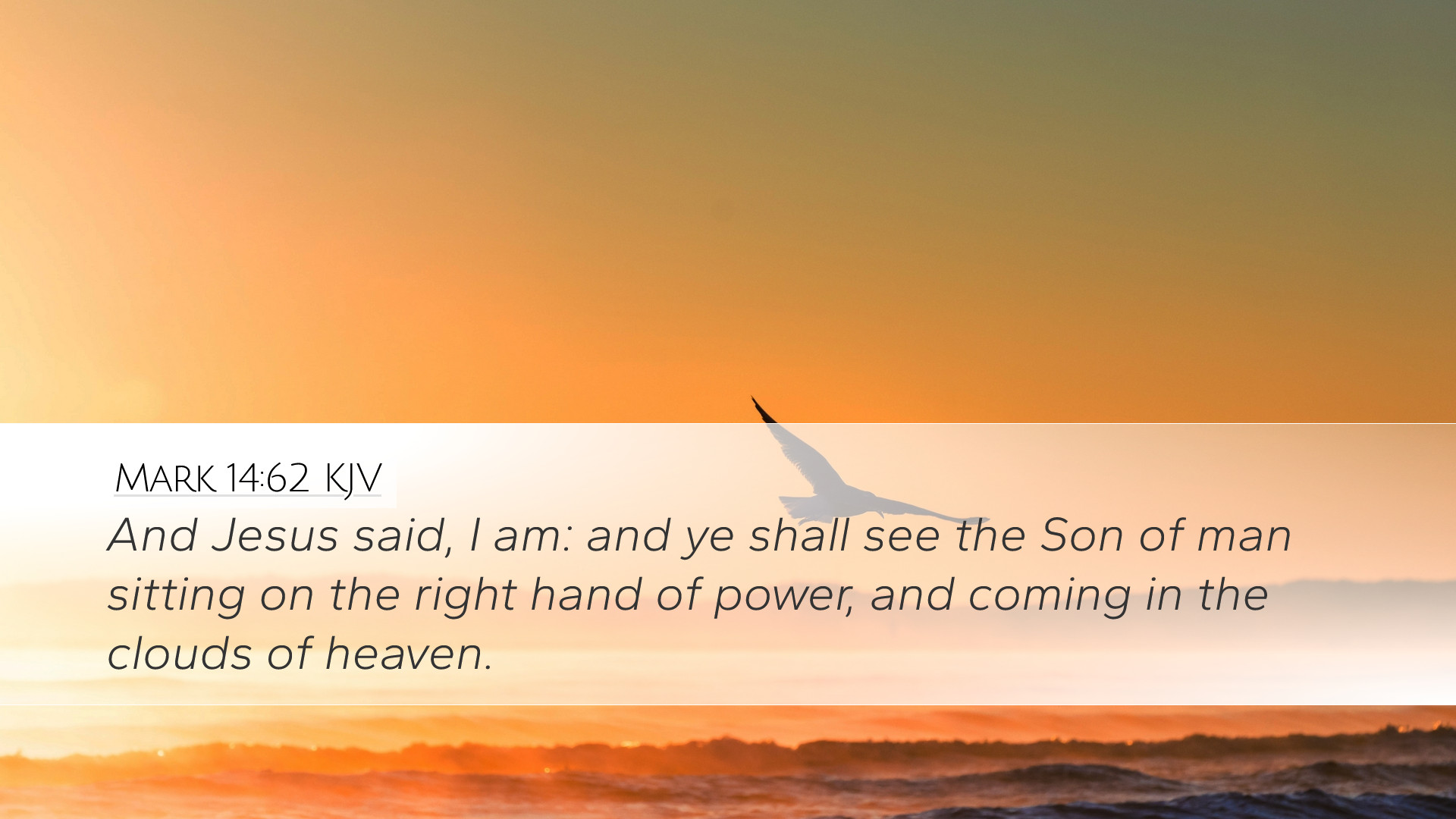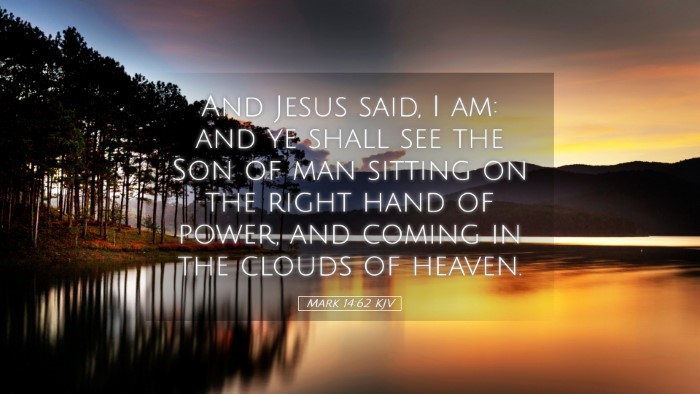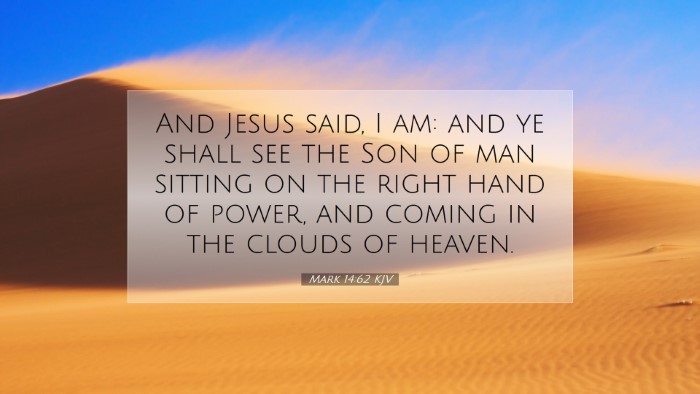Commentary on Mark 14:62
Mark 14:62 reads, "And Jesus said, I am: and ye shall see the Son of man sitting on the right hand of power, and coming in the clouds of heaven." This verse occurs during the trial of Jesus before the Sanhedrin, a crucial moment that culminates in the decision to hand Him over to the Romans for crucifixion. In this commentary, we will draw insights from public domain sources, including Matthew Henry, Albert Barnes, and Adam Clarke, providing a detailed theological exploration of this significant passage.
Contextual Overview
To fully understand Mark 14:62, it is essential to consider its context. Jesus stands before the high priest, who interrogates Him about His identity. The preceding verses highlight the tension and animosity from the religious leaders, as they seek evidence against Him. Here, Jesus openly identifies Himself, leading to a crucial theological revelation.
The I AM Statement
Jesus begins His response with "I am." This declaration is rich with significance. According to Albert Barnes, this phrase directly alludes to God's self-identification in Exodus 3:14, where God calls Himself "I AM." By using this expression, Jesus not only confirms His identity but also asserts His divinity.
-
Implication of Divinity: Matthew Henry emphasizes that this proclamation indicates Jesus' divine nature. He suggests that by stating "I am", Jesus is not merely identifying Himself but is offering a revelation of His eternal existence and divine authority.
-
Messianic Claim: This statement encapsulates Jesus’ claim to be the Messiah, the anointed one who fulfills Old Testament prophecies. Clarke notes that this assertion was particularly provocative, as it placed Jesus in direct opposition to the religious leaders who rejected Him.
Sitting at the Right Hand of Power
The second part of Jesus' statement, "and ye shall see the Son of man sitting on the right hand of power," is another profound declaration. This imagery conveys the authority and sovereignty of Jesus, as the right hand of power is a position of honor and strength.
-
Symbol of Authority: According to Albert Barnes, sitting at the right hand signifies a place of authority in heaven, reinforcing the belief that Jesus will reign victoriously despite His current humiliation.
-
Fulfillment of Prophecy: Clarke draws attention to Psalm 110:1, which foretells the Messiah's exaltation at God's right hand. This connection emphasizes that Jesus is the fulfillment of this Messianic prophecy and positions Him as sovereign over all.
Coming in the Clouds of Heaven
Finally, the phrase "coming in the clouds of heaven" indicates a future event of great significance. This statement not only reflects the majesty of Christ's return but also serves as a reminder of judgment.
-
Eschatological Significance: Matthew Henry comments on this aspect by stating that the coming in the clouds illustrates Christ’s return during the Second Coming, where He will come in glory to judge the living and the dead.
-
Encouragement to Believers: This declaration is a source of hope for followers of Christ. Barnes indicates that the promise of Christ’s return serves to strengthen believers’ faith and encourages them to persevere despite current struggles and persecutions.
Theological Implications
The implications of Mark 14:62 extend far beyond the immediate context of Jesus’ trial. This verse speaks volumes about the nature and mission of Jesus.
-
Nature of Christ: The dual affirmation of Jesus as both the Son of Man and divine encapsulates the Christological debate that has persisted throughout church history. His identification with humanity (Son of Man) affirms His role as the Savior who experienced human suffering while His divine attributes signify His authority over all creation.
-
Christian Hope: The promise of return reminds Christians of their ultimate hope in eternal life and the restoration of all things. This serves as a calling to live in anticipation of His coming and to order lives according to His teachings and authority.
Historical Reflection and Application
Throughout Christian history, this verse has been foundational to the understanding of Jesus’ identity and authority. It has been referenced in creeds and confessions and serves as a touchstone for discussions on eschatology and Christology.
-
Pastoral Application: For pastors and church leaders, Mark 14:62 presents both a challenge and an encouragement. It calls for a bold proclamation of Christ’s identity in a culture that often seeks to dilute the message of the Gospel.
-
Encouragement for Students and Scholars: For students and scholars, the verse serves as a reminder of the historical and theological significance of Jesus' claims. Engaging with this text invites deeper exploration into the implications of Christ's divine authority and His fulfilling of prophetic scripture.
Conclusion
Mark 14:62 is a pivotal verse that encapsulates the essence of who Jesus is and the hope He brings. Through careful reflection on this passage, one can appreciate its depth and the powerful truths it communicates about the intersection of divinity and humanity within the person of Christ. The insights drawn from Matthew Henry, Albert Barnes, and Adam Clarke invite us to explore the multifaceted dimensions of Christ’s identity as well as the implications of His words for both our present and future.


